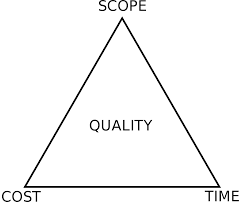
I remember my 1st Project Management Course very well from back in the 1990s when I worked at Bell. The constraint theory taught had Time, Cost, Scope and Quality all at the perimeter (and I know, some teachings only use the last 3), and we were told that after a project is defined, if anything changes with one of these variables, then one of the remaining three will have to give (ie. they are all interdependent). It seemed very simple (and still does), notwithstanding the difficulty in making the decision on which lever to adjust for certain projects when the inevitable hiccup occurs (those darn stakeholders and their opposing priorities) 🙂
More recently, I’ve seen other pictograms showing 6-9 elements of a project, and even one showing 3 3-dimensional layers, depicting Schedule, HR, Risk and Communication as other core elements. Are they necessary? Some say yes, including many key voices in the PM community. But I ask, does it change the core triangle? Not in any meaningful way, IMHO.
I’ve been fortunate, despite not finishing a PMP, I’ve always found the skill of managing projects has come very easily to me. There is a simple logic which ties those variables I mentioned earlier together, and it is often very clear on what needs to be done; avoiding scope creep, who needs to know what, where your risks are, and where the tightest timeline is.
So is risk management, scheduling, and team communication all part of introducing and leading a project? Absolutely, just as having stakeholders report outs, managing your vendors, financial accountability, and numerous other aspects. But are they a part of the core of the PM triangle? I don’t think so. These aspects don’t change what actually has to happen to ensure the project is completed. Now they do add to the framework of the project, and even enable the project to ensure it is *successful*, which we’d all agree is the real end goal.
I’m not saying discount these factors, indeed, you likely won’t have a successful project without them, but without them, yes, you do still have a project to manage. For me, it is the KISS philosophy. Keep the project well defined, but don’t lose sight of all the related “support” actions. Most of the bolt-ons to PM over the years have an element of redundancy to what was initially created. Cost and resources overlap, as do scope and schedule. If one has the right mindset and experience, one’s already considering all of these as one’s leading projects. Communication is the one nuance. Yes, it isn’t directly labelled in the triangle, though I would hope it’s folly that people go into a project without realizing they’ll need to communicate with multiple layers of the organization (and customers and vendors), on different aspects of the project. Today’s companies insist things are properly communicated, both to avoid surprises and to be transparent with their workforce.
Regardless of your approach, be mindful of all the aspects of introducing a change and leading a project (technical and people), and the post-mortem will be short, and the celebrations and recognition long.
Finally, let me wish you and your families and Merry Christmas and a Happy New Year. I’m going to enjoy the next few weeks with family and friends (and yes, plenty of sweets) and will return in January with some insights on Industry 4.0 and what the next decade could look like.
Darren
